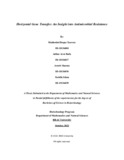Horizontal gene transfer: an insight into antimicrobial resistance
Abstract
Antimicrobial resistance (AMR), which affects a variety of infectious pathogens, is a pivotal
public health issue for many countries and corporations. Governments across the globe are
starting to take heed of an issue that is so grave that it jeopardizes the advancements of advanced
medication such as antibiotics. A key factor in the spread of antibiotic resistance is horizontal
gene transfer (HGT). Contrarily, it is periodically presumed that antibiotics stimulate HGT. A
comprehensive review of the research, however, indicates that there is insufficient credible data
available to support such a hypothesis in principle. This is primarily due to the insufficiency of
concise quantitative studies to answer this query. We assess how significantly HGT correlates to
the antibiotic resistance spread in this study, as well as what is documented about how antibiotics
regulate the mechanics of HGT. Our attention is on conjugation, the predominant HGT method
that is primarily responsible for the global spread of antibiotic resistance. According to our
research results, trials to quantify HGT must be planned in a systematic way in order to critically
evaluate the outcomes. Such experiments are crucial for constructing cutting-edge approaches to
inhibit the propagation of resistance by HGT. In this study, we explore about how much HGT
contributes to the spread of antibiotic resistance and explore what is known about how antibiotics
affect the dynamics of HGT including a brief discussion on antibiotic resistome.

